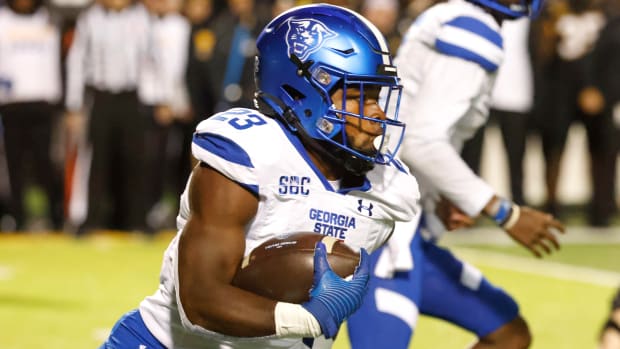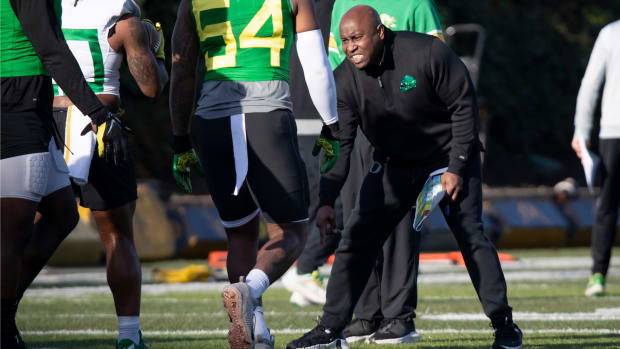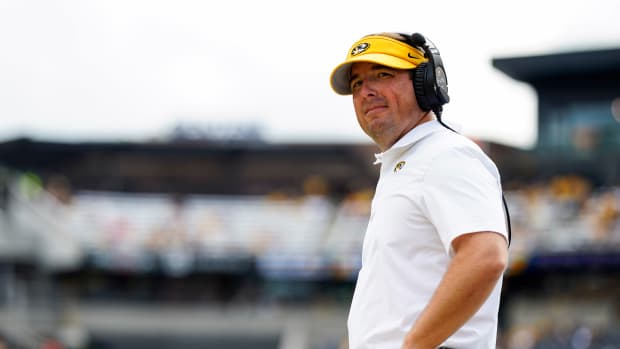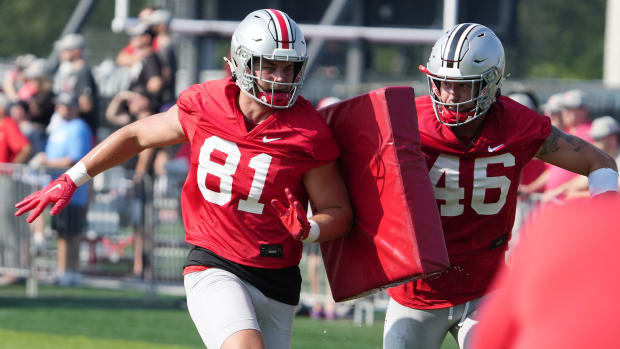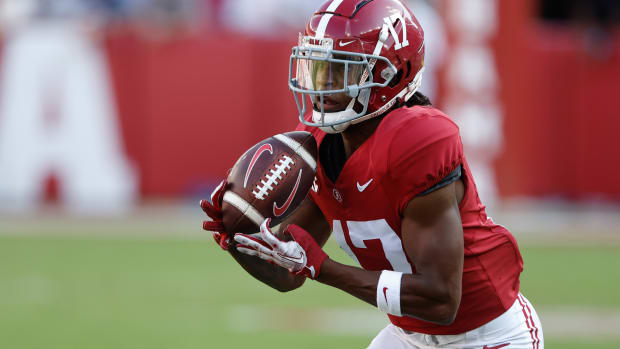An Impossible Job: Inside My Long Day as a College Football Line Judge
ATHENS, Ga. — Tim Beard is not bragging. He’s warning me.
You have reached your limit of 4 premium articles
Register your email to get 1 more
“Of all the positions,” the veteran SEC line judge says, “we watch more people and more things prior to the snap.”
It’s Friday night. On Saturday afternoon, I’ll be thrown into the Georgia spring game with a whistle around my neck, stripes on my shirt and an L on my back. For much of Friday night and much of Saturday morning, Beard will remind me of all the people and things I must watch. When I take my position on the line of scrimmage on the first play of the second series on Saturday afternoon, I will forget them all.
For the third consecutive season, the SEC invited a group of us who write and talk about college football to attempt to officiate a spring game. The idea is for us to have a little more empathy when we see a controversial call and a lot more understanding of how the officials reach their conclusions. I never considered myself overly critical of officials. I always appreciated that their job was difficult and thankless. But after spending a little more than half a spring game as a working line judge, I came to a different conclusion.
Their jobs are nearly impossible. I don’t know how anyone does it, but bless the people brave enough who stand out there in stripes for the rest of us to judge.
I realize that Beard started officiating when I was in diapers and has worked in the SEC since 2006, so he should have much of this committed to muscle memory by now. But the sheer volume of what he must assess and compute before, during and after a play is mind-blowing. Each official has his own set of responsibilities. The umpire must watch for holding and also avoid getting clobbered by double-teaming offensive linemen or used as a pick by a crossing slot receiver. The field judge must ensure the defense has 11 players on every single play and haul tail to the goal line on any deep pass. The referee must maintain order, communicate with every member of the crew and communicate what is happening to the players and coaches on the field, the thousands of people in the stadium and the millions watching at home.
But Beard probably is correct. Of all the officials, the line judge and the head linesman—his counterpart at the line of scrimmage on the other sideline—must pay attention to the most different things. Here is a list of all I was supposed to do:
Pre-snap
• Make sure my down marker, a velcro wrist strap with a string that goes around the number of fingers corresponding to the down, is correct.
• Make sure there are no more than four players in the backfield.
• Make sure the end man on the line of scrimmage (usually a receiver split wide) isn’t covering up a player wearing an eligible number on the line of scrimmage (usually a tight end) and rendering him ineligible.
• Find my key by looking at the players lined up to my side. If it’s a balanced formation, I have the tailback. If it’s a trips formation to my side, I have the second receiver until he gets into his route. When he does, I scan back toward the line of scrimmage.
• If the receiver nearest me is off the line of scrimmage, I hold a fist toward the backfield so the head linesman can keep his count on the other side. If the two outside receivers are off the line of scrimmage, I hold out two fingers.
• I have the call if an offensive player to my side false starts or if a defensive player jumps offsides. If it’s an offensive player, I must blow the whistle, drop my marker (the flag), kill the clock (waving hands above my head). I then must report the number of the offender to the referee and to the coaches on the sideline. If it’s a defensive player (and he doesn’t touch anyone), I must remember to drop my flag and let the play go. The offensive players wouldn’t be pleased if I blew their free play dead.
With Georgia’s offense, we had 15–20 seconds to process all that and do all that I’ll list for the post-play resposibilities. If we’d been at the Auburn spring game, we’d have had between eight and 10 seconds.

Among the numerous pre-snap responsibilities of the line judge: signaling to the other officials that the widest receiver is not on the line of scrimmage.
Gary McGriff/Southeastern Conference
During the play
• I follow my key (usually the tailback). If the play comes to my side, I need to be prepared to spot the ball where the ballcarrier gets tackled.
• I must signal on any ball exchange other than a handoff. I punch my fist back on a backward pass and forward on a forward pass. Had I been an actual official, I’d have been wearing the official-to-official radio. I would have verbalized whether the pass was caught behind or beyond the line of scrimmage. I’d also look for ineligible numbers beyond three yards from the line of scrimmage on passes caught beyond the line of scrimmage.
• On a sweep to my side, I need to pay attention to the perimeter blockers and watch for holding. If the defender isn’t trying to disengage, the flag stays tucked in my belt. If that defender starts moving away and a receiver reels him in with a handful of jersey, that play is coming back.
• I must watch for intentional grounding on incomplete passes. Other officials may not have a view of whether any receivers were in the area.
• If I have the better view, the center judge my rely on my spot even if the play ends on the other side of the field.
• On a pass near me, I need to make sure the receiver’s feet are in bounds and make sure he secured the catch. The field judge is watching this as well. Between the two of us, we should have a clear picture. The pro officials offered some advice on the order of checking: Feet. Ball. Because if there isn’t a foot in bounds, it doesn’t matter if the player caught the ball.
• If the ballcarrier goes out of bounds near me, I must wave my hands over my head to kill the clock while spotting the ball accurately.
• On a spot foul to my side—short defensive pass interference, for example—I need to mark the spot so the umpire and center judge can accurately walk off the penalty.
• If the play starts inside the plus-seven yard line, I must immediately get to the goal line in case I must determine whether a ballcarrier broke the plane. (As I learned the hard way Saturday, I can’t neglect my other duties even though this one has been tacked on.)
After the play
• On plays that go out of bounds, I must spot the ball while also ensuring that there is no extracurricular activity in the bench area. When a player gets tackled over the opposing sideline, I need to maintain control because there is a greater risk of a fight.
• If the play ended on my side, I need to make sure a ball gets back to the hashmark. This might be the ball from the play that just ended, or—if that ball is too far away—it will be the ball a team staffer just handed me. I need to throw the ball underhand and quickly, because we look like idiots if the umpire has to chase a ball I one-hopped to him.
• If there is a penalty, I need to move to the spot of the foul or the original line of scrimmage—depending on the call—and remind the umpire and center judge how far they need to walk. I hold out one finger for five yards, two fingers for 10 yards and three fingers for 15 yards. Then I walk parallel to them on the sideline as they go to the new spot.
• I must adjust my down marker correctly so we don’t wind up giving a team a fifth down like that crew in the 1990 Missouri-Colorado game did.
I can safely say there wasn’t a single play where I did all that stuff correctly. If I remembered a third of it, I was lucky. I spent most pre-snap seconds memorizing the numbers of the guard, tackle and tight end to my side so I could accurately report a false start. Thankfully, Georgia’s line of scrimmage players were very disciplined Saturday, because I have no idea how I would have blown the whistle, dropped the flag, killed the clock and remembered the number of the offending player.
The line judges out there will appreciate this, but no one else will. My best play was a trick play. Quarterback Dwan Mathis took the snap and gave the ball to James Cook, who flipped it to Matt Landers. I correctly indicated to my fellow officials that these exchanges were backward, so a forward pass was still in play. Mathis had taken off down the right sideline. Landers launched the ball. I punched toward the end zone, indicating a forward pass. The field judge (ESPN’s Molly McGrath) was in perfect position to call a touchdown as Mathis crossed the goal line. Associated Press writer Ralph Russo, who split time with McGrath at field judge, came to me between series. “Was that a reverse pass?” he asked. This wasn’t a dumb question. Russo was reading the field judge keys, so he never would have seen the action in the backfield. This is why it’s critical for members of a crew to trust one another. Everyone can’t see everything. Each official helps put the puzzle together on each play.
That’s why I can’t tell you much about what Georgia’s team looks like. How did quarterback Jake Fromm play? I have no idea. Did that massive offensive line dominate? I don’t know, but I know the players on my side didn’t false start.
I got very excited about correctly indicating those exchanges, because Beard had been on me for two quarters about forward/backward and behind/beyond calls. This was a major breakthrough. Unfortunately, pretty much every other play was a lowlight.
When actual SEC officials finish a game, they head back to their hotel for an immediate debriefing/critique from a conference observer—a former official who sat in the press box and graded their work. If they’re terribly unlucky, they’ll have Larry Rose as their observer. Rose doesn’t miss anything. His critiques are as pointed and as accurate as any that a coach will offer his players after watching the video. Rose only had 10 minutes to go over our work, but he had plenty to say to me:
• On one play, a tight end caught a pass and went out of bounds right in front of me. I spotted the ball accurately but didn’t kill the clock. This amused Rose to no end, because I’d spent several previous plays winding the clock or killing the clock when I didn’t need to. After one play, I got caught between winding and killing and looked like I was doing arm circles to warm up for a workout. “What is he doing with his arm?” my spy in the booth (USA Today’s George Schroeder, our replay official) caught Rose saying. Of course, when I actually needed to kill or wind the clock, my hands remained at my sides.
• In the red zone near the end of the second quarter, Fromm threw a ball out of bounds near me. I had correctly moved from the line of scrimmage to the goal line to watch for a potential touchdown. I had thought it odd that there weren’t any receivers in the area when the ball skidded past me. Rose pointed out that I should have done something with that information instead of turning around to pick up the ball. Fromm had been under pressure. We should have flagged him for intentional grounding, but I didn’t provide the key piece of evidence to the referee.
• On another play, I watched a bang-bang incomplete pass and turned to spot the ball, confident that defensive back Tyson Campbell had made a tremendous play to bat down the ball. His left hand had been on the receiver’s waist, but he didn’t appear to be tugging. He reached out with his right hand and swatted the ball. As coaches on the sideline harangued me for not throwing a flag, I explained that it wasn’t pass interference. As I was talking to the coaches, McGrath threw her flag. I should have run to the middle of the field to argue Campbell’s case to SEC director of officials Steve Shaw, who was foolhardy/patient enough to serve as our referee. I also should have been marking the spot of the foul. I did neither. Rose agreed with me that it wasn’t pass interference, but he also blamed me for not sticking up for my opinion.
• The one time I did throw my flag, it was beautiful. It was a high, arcing throw at what I was sure was a pass interference foul on the opposite side of the field in the third quarter. “Please don’t throw it,” Georgia coach Kirby Smart said on the SEC Network broadcast a tenth of a second before my flag flew onto the screen. “He just finished his bag of pork rinds just in time to throw the flag,” SEC Network analyst Matt Stinchcomb, a College Football Hall of Famer and professional Mack Brown impersonator, said immediately after I was identified as the flag thrower. Defensive back Chris Smith had collided with Landers as the ball arrived, and I was sure Smith had initiated the contact and knocked Landers off the spot by hitting him in the thigh. Our back judge (ESPN play-by-play man Sean McDonough) had a much more complete view of the play and told me both players were going after the ball and equally responsible for the collision. This was all I needed to talk me into picking up the flag, because I couldn’t remember the number of the player I had flagged. I was so worried about throwing the flag and justifying the call that the number had completely slipped my mind. I told Shaw to wave it off and slinked back to my sideline. I now feel even better about my decision to name McDonough to my dream college football broadcast crew, because he saved me from a terrible call. In his post-mortem, Rose agreed that I made a horrible decision to throw the flag.
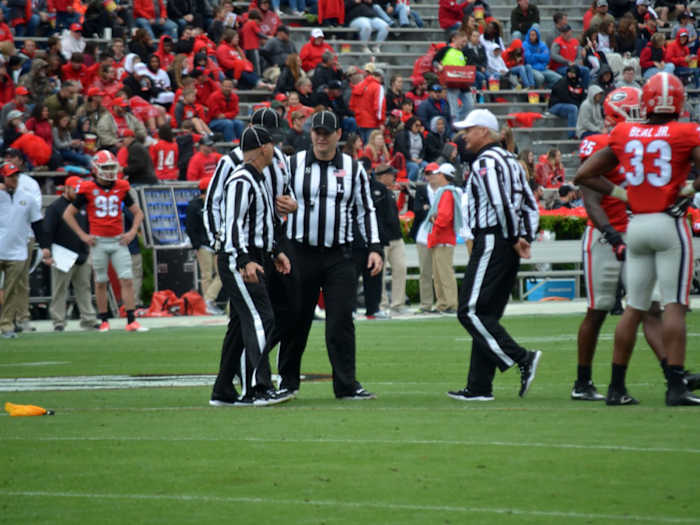
A beautiful flag toss was marred by an awful pass interference call.
Gary McGriff/Southeastern Conference
• On another play, I combined with the center judge (ESPN’s Marty Smith, who looked like he might throw up before we took the field) to turn an incomplete pass on first down into second-and-11. I had moved slightly behind the line of scrimmage grabbing a new ball to throw to the umpire (ESPN commentator and former Oklahoma star Dusty Dvoracek), but Marty spotted the ball based on where I was standing. I kept yelling “Turn around and look at the stick!” I could have just moved myself even with the stick and he would have moved the ball, but that would have required me to think of that in the moment. My apologies, Marty.
And my apologies to the Georgia players and coaches who had to endure me as an official during their spring game. Hopefully, I didn’t foul it up too much. I definitely learned a lot—including one final lesson from Rose after he finished ripping our performance.
“That’s not full speed,” he said.
So when LSU plays at Alabama in November and everyone is most assuredly going full speed, I’ll say a little prayer for the line judge. Because he needs all the support he can get on every play.
A Random Ranking
Of course we’re ranking football officiating positions. This isn’t a rank of our performances in these roles, however. Those were all bad. But I know what positions I’m placing in the top two spots in honor of Beard and SEC head linesman Johnny Crawford, who were incredibly generous with their time and unfailingly patient when they answered all my stupid questions.
1. Line judge
2. Head linesman
3. Umpire
4. Referee
5. Back judge
6. Center judge
7. Side judge
8. Field judge
Three And Out
1. The tinfoil hat version of LSU’s decision to hire athletic director Scott Woodward away from Texas A&M is that Woodward will eventually try to steal away Jimbo Fisher, the coach the Tigers coveted when Les Miles was fired. The reason for this? While Fisher’s 10-year, $75 million contract is fully guaranteed by Texas A&M, Fisher can walk away at no cost.
This wasn’t a secret plan by Woodward to take Fisher to his next job, though. Woodward said it himself in the story I wrote last year on the deal that brought Fisher to College Station: He had no leverage. So he had to offer a deal that was incredibly favorable to Fisher.
Here’s why no one needs to worry about that scenario. As long as Nick Saban is at Alabama, it’s not safe to bet on any sort of happy endings elsewhere in the SEC West. But Fisher and LSU’s Ed Orgeron seem capable of succeeding long term. If Orgeron wins, there is no issue. If Fisher wins, he’s not going anywhere, either. The only scenario in which Fisher would want to leave Texas A&M is if he’s unsuccessful. If that happened, everyone at A&M would be happy to let him walk away without the Aggies having to pay the buyout. So that situation would work itself out. (But it’s not going to happen that way.)
2. That said, SI’s Ross Dellenger explained why Woodward made the move.
3. UCF quarterback McKenzie Milton discussed his horrific knee injury and the long rehab process ahead with ESPN’s Andrea Adelson.
What’s Eating Andy?
The second college basketball corruption trial begins Monday in federal court in New York, but it may not be as juicy as originally expected. The judge ruled last week that neither Arizona coach Sean Miller nor LSU coach Will Wade would have to testify. They had been subpoenaed by the defense in an effort to show how the sausage is made in college hoops.
Hearing sitting head coaches testify under oath about what actually happens in recruiting would have been fascinating. But it’s not happening. Our popcorn will remain unpopped.
What’s Andy Eating?
There are certain rules that separate us from the less civilized beasts that don’t build skyscrapers, write novels or spend time arguing about whether a hot dog is a sandwich. One of those rules is this: Don’t put sugar in grits.
Butter, salt and pepper? Absolutely. They’ll taste terrible otherwise. Yankees try to eat grits plain and then dismiss them. Of course they’re awful plain. Everyone knows this. So dress them properly. But do not use sugar.
Unless you’re making grits ice cream.
We’ve managed to cram bacon into every part of every meal, so it only makes sense that someone would find a way to get grits into dessert. That someone is Mimi Maumus, the chef/owner at home.made in Athens. Maumus mastered the art of cooking Southern staples so thoroughly—this becomes obvious after a few bites of her appetizers and main courses—that she decided to experiment. Everyone loves fried green tomatoes. Everyone who knows how to eat them properly loves grits. Could a brunch appetizer and a breakfast side be combined into a dessert that creates the flavor version of mixing the episode of Designing Women that Lewis Grizzard guest-starred on with the hook to Outkast’s “ATLiens” and running it on a loop for 24 hours?
Yes. Yes it can.
The grits ice cream in the Green Tomato Crisp didn’t scare me off because there’s a place where I live that makes a delicious corn ice cream. (I needed to be talked into trying it, but once I did, I became a proselytizer.) Grits are made from corn, so I figured this would be similar. Imagine creamed corn bolstered with actual cream and sugar and you’ll understand that flavor. The grits ice cream wasn’t quite so sweet, but that helped the dish. What makes the Green Tomato Crisp so great is the range of flavors. The baked green tomato feels like a baked apple, but it’s much more tart. Then comes the ice cream, which is sweet but not overpowering. Then comes the caramel and streusel. These provide the sugary muscle—almost like the dessert for your dessert. The journey from tart to sweet and everywhere in between in each bite makes it the most intriguing thing on the menu.
The bigger issue at home.made is saving room for dessert. You’ll have to try the Medjool dates stuffed with pimento cheese and almonds. You’ll eat way too many pepper jelly pecans. You’ll savor every bite of the fried chicken thighs. You’ll try to conquer the Mayberry—a massive fried chicken biscuit with pimento cheese, pepper jelly and bacon—but you may have to take a little home.
Because you want that grits ice cream. You need that baked green tomato. And it’s going to take every ounce of willpower you have to leave space for them.



